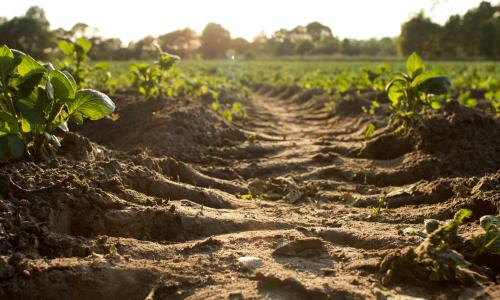
Healthy soil for more nutritious food and healthier planet
Main image credit: Dylan de Jonge/Unsplash
This article has been published on The Jakarta Post on December 12, 2022.
Soil has been widely recognized as the foundation of the food system, which produces 95 percent of our food. In the opening speech of the Group of 20 Summit last month, President Joko “Jokowi” Widodo emphasized the urgency to maintain food security during the Russia war crisis and COVID-19 pandemic, which have not yet come to an end.
Unfortunately, the urgency to protect and maintain our soil conditions has yet to become the top priority of current agricultural policies. The conversion of rice fields to non-agricultural land is around 100,000 hectares (ha) per year. Opening new rice fields is not easy, as the government has intended to improve national food security. Research by Setyorini et al. in 2010 found that the new rice fields in Indonesia were not supported by healthy soil, good water quality and enough microorganism to produce maximum yields.
The World Soil Day (WSD), which we commemorate annually every Dec. 5, reminds us to pay attention to the importance of healthy soil and to advocate for the sustainable management of soil resources. This year’s tagline “Soils: where food begins” aims to raise awareness of the importance of maintaining healthy ecosystems and human well-being by addressing the growing challenges in soil management, increasing soil awareness and encouraging societies to improve soil health.
Indonesia has attained “self-sufficiency” in some staple foods, particularly in rice, but we must ensure the proposed agenda provides a vision for a healthier planet and people.
From the environmental perspectives, rice production contributes to global warming through greenhouse gas (GHGs) emissions such as methane and nitrous oxide. More specifically, a study by Susilawati et al. in 2015 found that methane emissions from rice fields were recently estimated at about 5-19 percent of the total global-methane emissions, due to continuous flooding and the use of inorganic fertilizer.
From a nutritional standpoint, managing soil health with sustainable agriculture practices and diversifying agriculture crops will lead to the nutrient density in harvested-crop products and enrich crop products destined for people’s consumption.
From the policy perspective, the Agriculture Minister Regulation No. 49/2021 states that the total allocation for subsidized fertilizer in 2022 is 8.87-9.55 million tons, which is only 2.27 million tons where 21.54 percent are organic. This shows that the government is still prioritizing the use of inorganic fertilizer, when studies argue that too much inorganic fertilizer could actually lead to less quality soil. Since plants only need a certain amount of fertilizer, increasing its subsidy might not be the best decision. The government intervention should focus more on improving soil conditions, since it is the government that provides nutrients for plants to grow and produce nutritious high-quality yields.
Therefore, more-sustainable strategies should be planned to improve soil fertility to achieve food security for a healthier planet and people. The government should focus on the following strategies: securing the current protected-rice fields, improving nutrient management and implementing agroecological principles.
First, we need to anticipate changes in the usage of our existing rice fields by giving incentives to local governments to protect their current agricultural land. Lahan Sawah Dilindungi (LSD) is the policy of protected rice fields by the Agrarian Affairs and Spatial Planning Ministry/National Land Agency (ATR/BPN) as the implementation of Presidential Regulation No. 59/2019 about controlling of land-use change. The ministry aims to regularly update their data on protected rice fields in the entire country.
This policy is a fundamental tool to predict future rice production to achieve national food security. A study suggests that a prediction of the potential for food production must consider the anticipated loss of cropland due to urbanization, since converted cropland is 30–40 percent more productive than new cropland.
Protecting existing farmland from urbanization would ease pressure on agriculture's expansion into natural habitats. The local government needs financial incentives to cover the trade-offs for keeping the current protected rice field and not converting the land for non-agricultural purposes. The fiscal instrument through the General Allocation Fund (DAU) and Special Allocation Fund (DAK) could be considered to restrain the conversion of rice fields in Indonesia.
Second, we need to improve our land nutrient management. Different kinds of soil and plants also have different needs of type and amount of nutrients. However, in Indonesia, farmers are farming based on the hereditary way, where the application of inorganic fertilizer, especially Nitrogen, Phosphorus and Potassium (NPK) is a rooted habit. The fertilizer subsidy from the government also could potentially increase the use of NPK fertilizer.
Therefore, the need for inorganic fertilizer has increased by around 5-7 percent. The overuse of inorganic fertilizer over a long period of time will decrease the quality of soil and contaminate the water and the ecosystem in general. The right nutrient management could increase the soil quality, which leads to a higher plant production while also contributing to the GHGs reduction.
Third, implementing agroecological principles in the current agriculture practices in Indonesia is imperative. As described by FAO, agroecology principles are a subset of sustainable agriculture that describe a healthy relationship between nature, social science, ecology, society, economics and the environment.
Agroecology is applied based on local knowledge and experience in meeting local-food needs. Since it is locally based, agroecology is directly tackling climate change. For example, as a volcanic country, Indonesia has 127 active volcanoes, which contain high levels of minerals such as millstone and biochar.
This high mineral content should be utilized as a source of soil amendments and formulated as organic fertilizer to restore carbon in land and improve soil fertility to boost crop production.